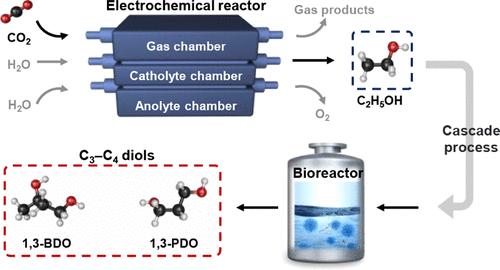协同电化学和人工智能辅助生物合成系统中CO2超快转化为C3-C4二醇的研究
IF 15.6
1区 化学
Q1 CHEMISTRY, MULTIDISCIPLINARY
引用次数: 0
摘要
使用二氧化碳作为原料生产高价值化学品是有吸引力的,但在技术应用方面仍然远远不够有效。特别是,将二氧化碳有效地转化为工业上重要的C3+二醇仍然是一个挑战。在这里,我们提出了一个碳负电化学-生物合成级联系统,用于直接从二氧化碳合成C3-C4二醇(1,3-丙二醇,1,3- pdo和1,3-丁二醇,1,3- bdo),生产率非常高。该集成平台结合了cuzn催化的电化学CO2还原反应器,在安培级电流密度(- 1100 mA cm-2)下生产乙醇(接近1200 μmol h-1 cm-2),以及用于C-C键扩展的生物催化模块。定制设计的J-T膜可以防止乙醇交叉,使累积量达到4.6 g L-1 h-1,而经过改造的Thermotoga maritima DERA变体(S233D/F43T)通过结合人工智能和合理设计的协同方法增强了催化效率,实现了1.8 g L-1 h-1的1,3- pdo产量。原位光谱研究表明,关键中间体*CO和*OH的存在,以及氢键网络的形成,显著增强了乙醇的电化学合成,而分子动力学模拟表明,突变诱导的DERA构象变化提高了底物亲和力。在1.0 g L-1 h-1的条件下,将乙醇扩展到1,3- bdo,进一步证明了该系统的多功能性。这项工作为从二氧化碳中合成多二氧化碳建立了一个可扩展的范例,弥合了电催化和可持续制造合成生物学之间的差距。本文章由计算机程序翻译,如有差异,请以英文原文为准。

Ultrafast Conversion of CO2 into C3–C4 Diols in a Synergistic Electrochemical and AI-Assisted Biosynthesis System
Using CO2 as a feedstock to produce high-value chemicals is attractive but remains far from effective in terms of technical application. In particular, efficient conversion of CO2 into industrially important C3+ diols is still challenging. Here, we present a carbon-negative electrochemical-biosynthesis cascade system for synthesizing C3–C4 diols (1,3-propanediol, 1,3-PDO, and 1,3-butanediol, 1,3-BDO) directly from CO2 at exceptionally high productivities. This integrated platform combines a CuZn-catalyzed electrochemical CO2 reduction reactor operating at Ampere-level current densities (−1,100 mA cm–2) to produce ethanol (close to 1,200 μmol h–1 cm–2) with a biocatalytic module for C–C bond extension. A custom-designed J-T membrane prevents ethanol crossover, enabling accumulation to 4.6 g L–1 h–1, while engineered Thermotoga maritima DERA variants (S233D/F43T) exhibit enhanced catalytic efficiency through a synergistic approach combining AI and rational design, achieving a 1,3-PDO production rate of 1.8 g L–1 h–1. In situ spectroscopic studies reveal that the presence of key intermediates *CO and *OH, along with the formation of a hydrogen-bonding network, significantly enhances the electrochemical synthesis of ethanol, while molecular dynamics simulations clarify mutation-induced conformational changes in DERA that improve substrate affinity. The system’s versatility is further demonstrated by extending ethanol to 1,3-BDO at 1.0 g L–1 h–1. This work establishes a scalable paradigm for synthesizing multi-carbon diols from CO2, bridging the gap between electrocatalysis and synthetic biology for sustainable manufacturing.
求助全文
通过发布文献求助,成功后即可免费获取论文全文。
去求助
来源期刊
CiteScore
24.40
自引率
6.00%
发文量
2398
审稿时长
1.6 months
期刊介绍:
The flagship journal of the American Chemical Society, known as the Journal of the American Chemical Society (JACS), has been a prestigious publication since its establishment in 1879. It holds a preeminent position in the field of chemistry and related interdisciplinary sciences. JACS is committed to disseminating cutting-edge research papers, covering a wide range of topics, and encompasses approximately 19,000 pages of Articles, Communications, and Perspectives annually. With a weekly publication frequency, JACS plays a vital role in advancing the field of chemistry by providing essential research.

 求助内容:
求助内容: 应助结果提醒方式:
应助结果提醒方式:


